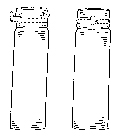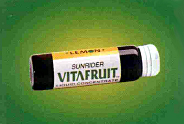TTAB Affirms Refusal Of Bottle Cap Trade Dress For Lack Of Distinctiveness
Like Icarus, Sunrider International crashed and burned in its attempt to register the packaging trade dress of its bottle cap as a trademark for nutritional supplements and herbal food beverages. The Board found that the purported trademark was not inherently distinctive and lacked acquired distinctiveness. In re The Sunrider Corp., Serial No. 74716136 (May 2, 2005) [not citable].

Sunrider's trade dress comprised the "connected top and bottom levels" of its cap. It disclaimed any rights in the bottle itself, or in the middle stage of the cap.
Inherent Distinctiveness: The Board distinguished this case from In re Creative Beauty Innovations Inc., 56 USPQ2d 1203 (TTAB 2000), in which the unique, unusual, and award-winning container configuration shown below for bath products and cosmetics, was found to be inherently distinctive.


Acquired Distinctiveness: In view of the nature of the claimed bottle cap design -- which consisted of "common geometric shapes ... particularly suited to covering the bottle (via the circular disk) and ensuring that the covering is not detached or separated from the bottle (via connection to the retention ring)" -- and in view of the diminutive size of the bottle cap (the entire cap is about one-half inch high and three quarters of an inch in diameter), the Board ruled that the evidence required to prove secondary meaning "ought to be rather significant."
Sunrider submitted a declaration attesting to five years of substantially exclusive and continuous use, and to growth in sales from 130,000 units in 1993 to 1,350,000 units in 1996. Three other declarations discussed the "perceived distinctiveness of applicant's container."
The Board observed that, depending on the nature of the mark, a five-year declaration may not be sufficient to establish a prima facie case of acquired distinctiveness. Moreover, the three other declarations did not focus on the top and bottom sections of the bottle cap, but rather on the middle section and on the bottle as a whole. Sunrider conceded that it does not advertise its products and its brochures show the products only in packaging. And as to the sales figures, "healthy sales alone do not prove purchaser recognition of a design proposed for registration." Distinguishing these facts from those in cases where the Board has found acquired distinctiveness, the Board ruled that Sunrider had failed to meet its Section 2(f) burden.
TTABlog comment: For a discussion of secondary meaning in the trade dress context, see my article entitled "Trade Dress and the TTAB: If Functionality Don't Get You, Nondistinctiveness Will."
Text ©John L. Welch 2005. All Rights Reserved.




0 Comments:
Post a Comment
<< Home